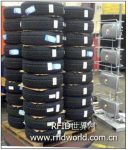
International logistics provider Logwin uses RFID to track tires
[ad_1]

Austrian international logistics provider Logwin uses RFID to track the assembly and delivery of tires for its car customers.
Logwin has 8,000 employees worldwide and its main operations are in Austria, Germany and Switzerland. Logwin provides tire assembly and warehousing services for some customers, such as automobile manufacturers and tire wholesalers. As the company’s steel tire rims are difficult to distinguish from each other, Logwin faces the risk of possibly confusing customer tires. This is why the company implemented a barcode system to track tires in early 2007.
However, Logwin also encountered a common problem with barcodes-due to wear, rubber tires will produce a certain type of rubber dust, making some barcodes unreadable. Moreover, workers often have to rotate tires weighing up to 16 kilograms to locate bar codes for scanning. Therefore, the company decided to use an RFID system to track tires, said Michael Peschek, Logwin’s director of operations.
Logwin produces 150,000 tires each year as part of its tire assembly value-added services. At the peak of this year’s autumn and winter tire sales, the company purely used the RFID system to track tires for the first time. Logwin sticks EPC Gen2 passive RFID tags on the tires, and the reader reads them when the tires are stacked on the pallet (10 tires high).
Most of the company’s tire production is completed between July and January. Customers usually put on winter tires during this period. This is also the period when many people decide to replace tires.To meet production needs, Logwin usually hires temporary workers
In October 2007, Logwin began to use RFID to solve the problem of the strip system, making it easier for seasonal workers to master the system. The company contacted GS1 Austria for a solution, and the latter introduced BSR Idware. BSR researched the RFID solution that is most suitable for Logwin’s application, as well as the best tire labeling position and the best installation position of the reader.
When the worker assembles the tire, the foreman checks the quality of the tire. If the tires are assembled correctly, the worker puts an adhesive RFID tag on each tire. The tires are then loaded onto pallets, passing through a pair of metal frames, and each tower is equipped with two RFID readers to read tire tags. Two readers are installed on the metal frame-an automatic conveyor belt is equipped on the wing side. If the reader recognizes that the number of tires in a certain batch is complete and the type is correct, the warehouse management system then allocates the pallet storage area, and the conveyor belt transfers the tire pallet to the storage area.
When the worker receives the customer order, the Logwin worker takes out the required tires and stacks them in groups of 10 on the pallet. The company uses RFID readers to repeatedly confirm the correct mathematics and categories. The pallet is then sent to a wrapping machine, where another pair of metal frames-each with four Motorola readers-read the tire RFID tags. When the pallet rotates and wraps the plastic film, the reader reads the tire again and confirms it. If the tire does not meet the customer’s order, the packaging machine automatically shuts down.
The advantage of this system, Peschek said, is its applicability to the industry environment. Rubber dust will not affect the reading of RFID tags. Because workers do not need to turn tires to find barcodes, it also saves time and labor. The RFID system also ensures that customers’ products will not be confused, and seasonal workers do not need to train the system to use it.
Logwin uses RFID printing and encoding machines manufactured by Zebra Technologies, which produces approximately 160,000-170,000 RFID tags per year.
[ad_2]



